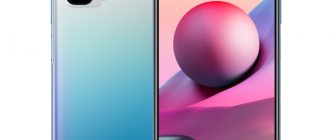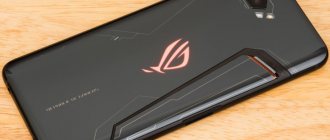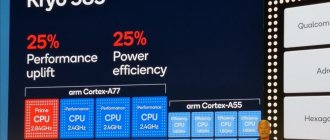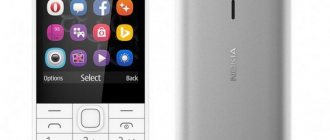Qualcomm continues to develop the segment of mid-budget processors with high randomness.
Snapdragon 730 and 730G became the successors to the Snapdragon 710, offering developers affordable single-chip systems with characteristics close to flagship ones. SD 730 is built on an 8nm process technology with 8 Kryo 470 cores, divided into 2 clusters:
- 2 powerful Cortex-A76 cores with a maximum frequency of 2.2 GHz.
- 6 energy-efficient Cortex-A55 cores with a frequency of 1.8 GHz.
Graphics processing is handled by Adreno 618, which supports DirectX 12, Vulkan, OpenGL ES 3.2, OpenCL 2.0. The chip is compatible with up to 8GB LPDDR4X RAM at 1866MHz. Support for internal memory in UFS 2.0 format has been implemented. The Hexagon 688 is installed as a digital signal processor, and the Spectra 350 is engaged in image processing. Smartphones on the Snapdragon 730 can be equipped with a single 48 MP camera or a dual 22 MP camera.
The difference between the Snapdragon 730G and the Snapdragon 730 is support for displays with a resolution of up to 3360 x 1440 and HDR10 technology, versus a maximum resolution of up to 2520 x 1080 for the base model. The gaming version with the letter G received an Adreno 618 overclocked by 25%. The neural AI Engine, Wi-Fi 6, the presence of a Snapdragon X15 LTE modem and support for Quick Charge 4+ fast charging were received by both processors. In AnTuTu, the average score of the Snapdragon 730 is 230,000 points.
Samsung
The first smartphone based on Snapdragon 730 was the Samsung Galaxy A80. In addition to the filling, the device is interesting due to its unusual design. The front panel is occupied by a 6.7-inch New Infinity Super AMOLED display with a resolution of 2400 x 1080. A fingerprint scanner, light and proximity sensor are placed under the screen. The earpiece is removed, and instead the interlocutor's speech is reproduced by the surface of the screen.
Samsung decided to experiment and created a retractable main camera mechanism that can serve as a selfie lens. The camera unit consists of a 48 MP main sensor, an 8 MP wide-angle sensor (angle 123°) and a depth sensor. The Galaxy A80 comes with 8/128 GB of memory. The 3,700 mAh battery supports 27W fast charging. Artificial intelligence algorithms extend battery life. The pre-installed Android 9.0 Pie is diluted with the ONE UI user interface.
At the end of 2022, the South Korean giant announced the Samsung Galaxy A71, developing a “budget” line. The front panel of the smartphone is occupied by a 6.7-inch SuperAMOLED display with a resolution of 2400 x 1080 and a dot cutout for a 32 MP front camera. The main camera consists of 4 modules, including a 64 MP main camera, a 12 MP wide-angle lens, a 5 MP portrait lens and a macro module.
The Snapdragon 730 is responsible for the performance of the smartphone. Memory variations differ in the amount of RAM: 6 or 8 GB. The internal storage is always 128 GB. The expansion slot is compatible with microSD memory cards up to 512 GB. The battery capacity is 4500 mAh and supports 25 W fast charging.
Qualcomm Snapdragon 730, 730G and 665: mid-range mobile platforms with improved AI
Qualcomm has introduced three new single-chip platforms designed for use in mid-price smartphones. The new products are called Snapdragon 730, 730G and 665, and, according to the manufacturer, they provide better AI and higher performance compared to their predecessors. In addition, they received some new features.
The Snapdragon 730 platform stands out primarily because it is capable of delivering twice as fast AI performance compared to its predecessor (Snapdragon 710). The new product received a proprietary AI processor Qualcomm AI Engine of the fourth generation, as well as a Hexagon 688 signal processor and a Spectra 350 image processor with support for computer vision. In addition to higher performance, power consumption when performing AI-related tasks has been reduced by up to four times compared to the Snapdragon 710.
Thanks to improvements in working with AI, smartphones based on the Snapdragon 730 will be able, for example, to shoot 4K HDR video in portrait mode, which was previously only available to models based on the flagship Snapdragon 8-series chips. In addition, the new platform supports work with three-camera systems and can also work with high-resolution depth sensors. There is support for the HEIF format, which allows you to use less space to store photos and videos.
The Snapdragon 730 is based on eight Kryo 470 cores. Two of them operate at up to 2.2 GHz and form a more powerful cluster. The remaining six are designed for more energy-efficient operation, and their frequency is 1.8 GHz. According to the manufacturer, the Snapdragon 730 will be up to 35% faster than its predecessor. The Adreno 618 graphics processor with support for Vulcan 1.1 is responsible for processing 3D graphics. There is also a Snapdragon X15 LTE modem with support for downloading data at speeds of up to 800 Mbit/s (LTE Cat. 15). Wi-Fi 6 standard is also supported.
The letter “G” in the name of the Snapdragon 730G platform is an abbreviation for the word “Gaming”, and it is intended for gaming smartphones. This chip features an improved Adreno 618 graphics processor, which will be up to 15% faster in graphics rendering than the standard Snapdragon 730 GPU. Popular games are also optimized for this platform. Technology has also been used to help reduce FPS drops and improve gameplay. Finally, this platform has the ability to control the priority of Wi-Fi connections to improve the quality of your network connection in games.
Finally, the Snapdragon 665 platform is designed for more affordable mid-range smartphones. Just like the Snapdragon 730 described above, this chip supports triple cameras and has an AI Engine AI processor, albeit of the third generation. It also provides AI assistance for portrait mode shooting, scene detection, and augmented reality.
The Snapdragon 665 is based on eight Kryo 260 cores with a frequency of up to 2.0 GHz. Graphics processing is handled by the less powerful Adreno 610 graphics processor, which also received support for Vulcan 1.1. There is a Spectra 165 image processor and a Hexagon 686 signal processor. Finally, it uses a Snapdragon X12 modem with download speeds of up to 600 Mbps (LTE Cat.12).
The first smartphones based on the Snapdragon 730, 730G and 665 single-chip platforms should appear around the middle of this year.
Xiaomi
After transforming the Redmi line into a separate brand, the newly formed company launched Redmi K20 for the Chinese market and Xiaomi Mi 9T for the rest of the world. The smartphone has a 6.39-inch AMOLED display with a resolution of 2340 x 1080 and a built-in fingerprint sensor. The front camera was placed in a pop-up mechanism. On the back cover there is a triple camera unit. A version with 6 GB of RAM and 64 or 128 GB of storage is available for purchase. The battery capacity was 4000 mAh. Detailed characteristics of the smartphone are on this page.
The Mi Note 10 model was the company's response to camera phones from other brands, introducing 5 modules to the back of the case: 108, 20, 12 and two 2 MP sensors. The publication DxOMark called the smartphone a universal device for photography and noted its excellent telephoto lens. The choice of processor is surprising - Snapdragon 730G instead of the flagship SD855. Breaking the mold was a massive 5260 mAh battery, which, in conjunction with QC 4.0 with a power of 30 W, completely restores the battery in 65 minutes. More about the smartphone is said in the announcement of its Chinese counterpart Xiaomi Mi CC9 Pro.
Redmi K30 is the successor to last year's Redmi K20, aka Xiaomi Mi 9T. The smartphone will appear in a version with 5G support, but the coveted Snapdragon 730G will only be installed in the version with 4G networks. Among the main features: the abandonment of the “periscope” in favor of an oval cutout on the display, an increase in the battery to 4500 mAh, an IPS screen instead of AMOLED. More details here.
What is the difference between Snapdragon 730 and Snapdragon 730G?
"G" stands for games. Qualcomm's Snapdragon 730G is almost identical to the Snapdragon 730, but is better optimized for gaming. The 730G includes the "Snapdragon Elite Gaming" package, which allows you to play relatively better graphics (Vulkan 1.1), maintain smooth gameplay, deliver powerful wireless audio while gaming, and more.
Read: Best gaming smartphones with Snapdragon 855+plus processor
The 730G also supports higher resolution displays (QHD+ vs Full HD+).
So basically for consumers who aren't interested in high-end gaming, the two chips should be equivalent.
Lenovo
Lenovo Z6 is announced as a competitor to Xiaomi Mi 9T on the same hardware platform. The front panel is occupied by a wide-format OLED display with a diagonal of 6.39 inches, a resolution of 2340 x 1080 and a fingerprint scanner built under it. There is support for the HDR10 standard and a drop-shaped cutout for a 16 MP camera with f/2.0 aperture.
On the back cover there is a 24 MP main camera, an 8 MP sensor with support for 2x optical zoom and a 5 MP depth sensor. In addition to the SD730, there are 6/8 GB of RAM and 64/128 GB of UFS 2.1 permanent memory inside. The smartphone's 4000 mAh battery is complemented by support for 15 W fast charging, which is connected via the USB Type-C port. There is a headphone output, Wi-Fi (2.4/5 GHz) and Bluetooth 5.0. There is no NFC chip. Lenovo Z6 runs on Android 9.0 Pie with the proprietary ZUI 11 interface.
Snapdragon 730 and 730G - review of top sub-flagship processors
The Snapdragon 7xx chipset line represents sub-flagship level solutions. Previously, the Snapdragon 660 solution was considered a pre-top solution, but the Snapdragon 710 chip and its modification in the form of the Snapdragon 712 have been on the market for a long time. Next, naturally, are top-end solutions such as Snapdragon 835, 845 and 855. If we talk about the 730th dragon , then this is a more advanced chip relative to the pioneer of the 700 line. The chipset mainly differs from its ancestor in the new core composition (Cortex-A76 + Cortex-A55), core frequency and production process, which has decreased from 10 nanometers to 8 nanometers. As Qualcomm itself reports, all these changes have a positive impact on the performance of the new processor, which has become 35% more powerful.
Naturally, the changes also affected the graphics accelerator. Instead of Adreno 616, the chipset includes a new video accelerator Adreno 618. The LTE modem has also been updated to the X15 level, which offers the Wi-Fi 6 wireless connection standard. The new Hexagon 688 signal processor has acquired a tensor accelerator, and this signal processor can also act as power for machine learning. Due to the increased power of individual chipset components and a reduction in the manufacturing process, artificial intelligence began to consume 400% less energy than in earlier products.
For image processing, the Snapdragon 730 uses an updated Spectra 350 processor. This powerful solution is capable of shooting video in 4K resolution in portrait HDR mode. Previously, only top-end chipsets from the 800 line could do this, so the Snapdragon 730 came very close to the flagship line. The processor also claims to support a new file encoding format in HEIF format to save space on the internal storage.
OPPO
Oppo Reno 2 became the only smartphone from the line of the same name built on the Snapdragon 730. The front panel of the device is equipped with a Dynamic AMOLED display with a diagonal of 6.5 inches and an aspect ratio of 20:9. Instead of cutouts for the front camera, a pop-up mechanism is used, where an LED flash is hidden along with a 16 megapixel lens.
On the rear panel there is a block of four cameras, led by a 48 MP Sony IMX586 sensor, an 8 MP wide-angle lens, a 13 MP telephoto module and a 2 MP monochrome sensor. From memory we get the only configuration in a combination of 8/256 GB. The 4000 mAh battery supports VOOC 3.0 fast charging.
The OPPO line was diluted by the K5 model based on Snapdragon 730G, seasoned with 6/8 GB of RAM and 128 GB of internal storage of UFS 2.1 type. The tray for 2 nanoSIM is combined with a slot for a microSD memory card up to 256 GB. On the front there is a 6.4-inch Super AMOLED display with a resolution of 2340 x 1080. The main camera includes 4 lenses, led by a 64 MP sensor. 4000 mAh battery with support for QC 4.0 fast charging, up to 30 W. There is NFC, USB Type-C and a 3.5 mm port.
Snapdragon 730: characteristics
Technical process . Flagship chips in 2022 are produced using 7 nm or 8 nm lithography standards. The best mid-range processors were previously produced using 10 nm lithography standards, but with the advent of the Snapdragon 730, the situation is changing. The new chip was the first representative of the 7 series produced using 8 nm lithography. Note that Qualcomm's competitors do not yet have comparable solutions for the middle class.
The transition to a finer technical process leads to a reduction in energy consumption. Will this affect the autonomy of smartphones running Snapdragon 730? The question is ambiguous. Compared to the Snapdragon 710, the new processor will consume less energy per operation, but the power increases, which means that the final autonomy will most likely remain at the same or comparable level. There will be no revolution.
Central processor . Kryo 470 cores , which are based on the ARM Cortex-A76 . Let us remember that Kryo 460 cores with a similar organization debuted in the Snapdragon 675 processor.
The Snapdragon 710 platform contains the previous generation Kryo 360 cores, based on the ARM Cortex-A75/A55 architecture.
Graphic arts . The next step forward is the Adreno 618 . The Snapdragon 730 chipset still uses simplified graphics (compared to flagship chips), but it is the best sixth-generation graphics adapter for mid-range processors so far. In terms of computing power, the Snapdragon 730 will surpass its predecessor. We’ll talk about how tangible the superiority will be in the next section.
Snapdragon 730G - what are the differences
Along with the Snapdragon 730, Qualcomm also presented a more powerful version of the chipset called 730G. The new product has not received any special changes, but the prefix “G” makes it clear that this is a gaming solution (G for gaming). The chipset received a video accelerator overclocked to the maximum frequency, due to which its performance increased by 25% relative to the basic version. The chip was also equipped with the Jank Reducer function, which minimizes frame rate loss and has uncheating functions. In addition to gaming performance, the Snapdragon 730G has the ability to record video at frame rates up to 960 fps, and also work with HDR10 displays with resolutions up to 1440P (2K).
Snapdragon 735 - review and characteristics of the Snapdragon 845 analogue
If the Snapdragon 730 and 730G chips are still in some ways inferior to the top solutions from the 800 line, then the Snapdragon 735 model is very close to the flagships. This chipset is superior to the Snapdragon 845 in some respects, but overall it cannot be considered a full replacement for last year’s top processor.
At the moment, it is known that the Snapdragon 735 will be made according to the standards of the 7-nanometer technological process, as well as the Snapdragon 855. The chip will also receive a three-cluster system, but slightly modified: 1 high-performance core + 1 medium core + 6 energy-efficient cores. As cores, the company decided to use the latest solutions from the Kryo 400 line (if not 470, then something between 470 and 485 (the latter are in the 855th dragon)). The maximum frequency of the leading core will be 2.9 GHz, the middle one 2.4 GHz, and the energy efficient one 1.8 GHz. Graphics performance will be provided by the Adreno 620 video accelerator with a clock frequency of up to 750 MHz and support for Quad HD+ displays with a resolution of 3360x1440 pixels. In addition, the chip will be able to work with displays with a wide color gamut HDR10 and HDR10+.
As for memory, it claims to support LPDDR4X RAM operating in dual-channel mode (2133 MHz) up to 16 GB. The internal drive will be able to work with the UFS 2.1 memory standard. It is also important that the Snapdragon 735 supports 5G networks, that is, we will soon be able to get sub-flagship devices that work in 5th generation networks. Finally, the new 735th dragon will receive an NPU 220 neural unit with a frequency of up to 1 GHz, which will be responsible for accelerating operations with machine learning and AI.











